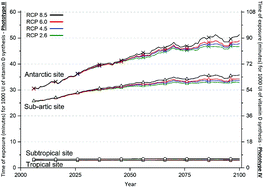当前位置:
X-MOL 学术
›
Photochem. Photobiol. Sci.
›
论文详情
Our official English website, www.x-mol.net, welcomes your
feedback! (Note: you will need to create a separate account there.)
Changes in the total ozone content over the period 2006 to 2100 and the effects on the erythemal and vitamin D effective UV doses for South America and Antarctica.
Photochemical & Photobiological Sciences ( IF 2.7 ) Pub Date : 2019-11-07 , DOI: 10.1039/c9pp00276f M P Corrêa 1 , A L C Yamamoto 1 , G R Moraes 1 , S Godin-Beekmann 2 , E Mahé 3
Photochemical & Photobiological Sciences ( IF 2.7 ) Pub Date : 2019-11-07 , DOI: 10.1039/c9pp00276f M P Corrêa 1 , A L C Yamamoto 1 , G R Moraes 1 , S Godin-Beekmann 2 , E Mahé 3
Affiliation

|
Recent studies show that the ozone layer will recover by the middle part of this century. This is a significant result arising from the Montreal Protocol, and highlights the success of this environmental protection agreement. Climate change projections show that Total Ozone Content (TOC) levels will increase significantly by the end of this century, mainly at higher latitudes. This increase may result in a reduction of the adverse effects of UV radiation overexposure. By contrast, reduced UV radiation levels at the surface of the Earth can result in reduced levels of vitamin D synthesis among the inhabitants of these regions. In this study we provide estimates for the UVI, erythemal, and vitamin-D weighted daily doses for ten different locations in South America and Antarctica. Our calculations were based on ozone projections provided by climate models set forth in the last IPCC report. Results show that the increase of TOC levels in middle and high latitude regions may result in decreased UVI and UV doses throughout the century. In high latitudes, erythemal doses and vitamin D synthesis doses may be reduced by up to 22 and 39%, respectively, if anthropogenic emissions continue to rise throughout the century. Furthermore, there may be reductions of up to 9 and 12%, respectively, in mid-latitudes (20°S to 35°S). Significant variations at Equatorial sites were not observed. In most of South America, the attenuation in UVR caused by increases in TOC during the 21st century is neither enough to promote protective effects from this radiation, nor for the lack of UVR for vitamin D synthesis. The incidence of UVR in tropical and sub-tropical areas of the continent will continue to be a public health risk for the entire 21st century during all seasons, regardless of the climatic scenarios. Our results can be used as an important tool for health studies focusing on the excess and/or lack of sun exposure.
中文翻译:

2006年至2100年期间,臭氧总含量的变化以及对南美和南极洲的红斑和维生素D有效紫外线剂量的影响。
最近的研究表明,臭氧层将在本世纪中叶恢复。这是《蒙特利尔议定书》产生的重大成果,突出了这项环境保护协定的成功。气候变化预测表明,到本世纪末,主要在高纬度地区,臭氧总含量(TOC)水平将显着增加。这种增加可导致减少紫外线辐射过度暴露的不利影响。相比之下,地球表面紫外线辐射水平的降低会导致这些地区居民中维生素D合成水平的降低。在这项研究中,我们提供了南美和南极洲十个不同地点的UVI,红斑和维生素D加权日剂量的估算值。我们的计算基于IPCC上次报告中提出的气候模型提供的臭氧预测。结果表明,整个中高纬度地区的TOC水平升高可能导致UVI和UV剂量降低。在高纬度地区,如果在整个世纪中人为排放量继续增加,则红斑剂量和维生素D合成剂量可能分别减少多达22%和39%。此外,在中纬度(20°S至35°S)中,降幅可能分别高达9%和12%。在赤道站点没有观察到明显的变化。在南美洲大部分地区,由21世纪TOC升高引起的UVR衰减既不足以促进这种辐射的保护作用,也不足以缺乏维生素D合成所需的UVR。在整个21世纪,无论气候条件如何,在整个21世纪,非洲大陆热带和亚热带地区的UVR发病率仍将是公共卫生风险。我们的研究结果可以用作健康研究的重要工具,重点研究过度和/或缺乏阳光照射。
更新日期:2019-12-04
中文翻译:

2006年至2100年期间,臭氧总含量的变化以及对南美和南极洲的红斑和维生素D有效紫外线剂量的影响。
最近的研究表明,臭氧层将在本世纪中叶恢复。这是《蒙特利尔议定书》产生的重大成果,突出了这项环境保护协定的成功。气候变化预测表明,到本世纪末,主要在高纬度地区,臭氧总含量(TOC)水平将显着增加。这种增加可导致减少紫外线辐射过度暴露的不利影响。相比之下,地球表面紫外线辐射水平的降低会导致这些地区居民中维生素D合成水平的降低。在这项研究中,我们提供了南美和南极洲十个不同地点的UVI,红斑和维生素D加权日剂量的估算值。我们的计算基于IPCC上次报告中提出的气候模型提供的臭氧预测。结果表明,整个中高纬度地区的TOC水平升高可能导致UVI和UV剂量降低。在高纬度地区,如果在整个世纪中人为排放量继续增加,则红斑剂量和维生素D合成剂量可能分别减少多达22%和39%。此外,在中纬度(20°S至35°S)中,降幅可能分别高达9%和12%。在赤道站点没有观察到明显的变化。在南美洲大部分地区,由21世纪TOC升高引起的UVR衰减既不足以促进这种辐射的保护作用,也不足以缺乏维生素D合成所需的UVR。在整个21世纪,无论气候条件如何,在整个21世纪,非洲大陆热带和亚热带地区的UVR发病率仍将是公共卫生风险。我们的研究结果可以用作健康研究的重要工具,重点研究过度和/或缺乏阳光照射。









































 京公网安备 11010802027423号
京公网安备 11010802027423号